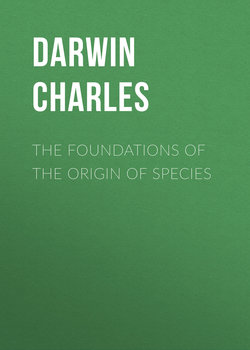Читать книгу The Foundations of the Origin of Species - Чарльз Дарвин, Darwin Charles - Страница 12
PART I
CHAPTER I
ON THE VARIATION OF ORGANIC BEINGS UNDER DOMESTICATION; AND ON THE PRINCIPLES OF SELECTION
On the hereditary tendency
ОглавлениеA volume might be filled with facts showing what a strong tendency there is to inheritance, in almost every case of the most trifling, as well as of the most remarkable congenital peculiarities191. The term congenital peculiarity, I may remark, is a loose expression and can only mean a peculiarity apparent when the part affected is nearly or fully developed: in the Second Part, I shall have to discuss at what period of the embryonic life connatal peculiarities probably first appear; and I shall then be able to show from some evidence, that at whatever period of life a new peculiarity first appears, it tends hereditarily to appear at a corresponding period192. Numerous though slight changes, slowly supervening in animals during mature life (often, though by no means always, taking the form of disease), are, as stated in the first paragraphs, very often hereditary. In plants, again, the buds which assume a different character from their stock likewise tend to transmit their new peculiarities. There is not sufficient reason to believe that either mutilations193 or changes of form produced by mechanical pressure, even if continued for hundreds of generations, or that any changes of structure quickly produced by disease, are inherited; it would appear as if the tissue of the part affected must slowly and freely grow into the new form, in order to be inheritable. There is a very great difference in the hereditary tendency of different peculiarities, and of the same peculiarity, in different individuals and species; thus twenty thousand seeds of the weeping ash have been sown and not one come up true; – out of seventeen seeds of the weeping yew, nearly all came up true. The ill-formed and almost monstrous “Niata” cattle of S. America and Ancon sheep, both when bred together and when crossed with other breeds, seem to transmit their peculiarities to their offspring as truly as the ordinary breeds. I can throw no light on these differences in the power of hereditary transmission. Breeders believe, and apparently with good cause, that a peculiarity generally becomes more firmly implanted after having passed through several generations; that is if one offspring out of twenty inherits a peculiarity from its parents, then its descendants will tend to transmit this peculiarity to a larger proportion than one in twenty; and so on in succeeding generations. I have said nothing about mental peculiarities being inheritable for I reserve this subject for a separate chapter.
191
See Origin, Ed. i. p. 13.
192
Origin, Ed. i. p. 86, vi. p. 105.
193
It is interesting to find that though the author, like his contemporaries, believed in the inheritance of acquired characters, he excluded the case of mutilation.
